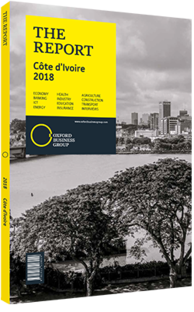Côte d'Ivoire looks to finance debt through eurobond issues
Although macroeconomic performance remains robust compared to peer countries, there is clear evidence of a slowdown driven by the 50% fall cocoa prices between the late-2015 peak and early 2018. This puts pressure on tax revenue and the fiscal deficit while slowing GDP growth. The result is a higher debt-to-GDP ratio than anticipated, causing a greater need for the government to raise funds from the financial markets.
The IMF originally forecast a slow but steady reduction in both the fiscal deficit and the debt-to-GDP ratio each year between 2016 and 2019. Rather than falling to 3.7% of GDP in 2017, however, the deficit was set to reach 4.5% (see analysis). Meanwhile, GDP is now expected to be 1.5% lower in 2019 than indicated in previous projections. These trends mean public debt is anticipated to peak at 48.7% of GDP in 2017 instead of 48.3% in 2016, as was initially projected by the IMF. As of late 2017 estimates, the debt-to-GDP ratio was expected to be 46.4%, rather than 44.9%, by 2019.
New Eurobond
In a sign of continued innovation in the financial markets and its confidence in taking on long-term, foreign-denominated debt, the Ivorian government tapped the eurobond market for the third time in its recent history in June 2017. Opting to raise funds in a foreign currency via a eurobond allows the government to avail itself of better financing opportunities. By transferring exchange-rate risk from the investor to the issuer, the state can raise funds at lower interest rates. Côte d’Ivoire’s previous eurobond transaction, which occurred in 2015, raised $1bn for the public purse, with the bonds maturing in 2028.
The 2017 eurobond issue amounted to nearly $2bn, consisting of $1.25bn and a further €625m. The dollar tranche carried an interest rate of 6.125% over its 16-year term, while the euro tranche carried a 5.125% rate over an eight-year term. While the euro tranche was originally set to be €500m in size, it was increased by 25% in agreement with the IMF, in light of the country’s higher-than-expected financing needs in 2017. The dollar tranche served in part to finance the buy-back of some $750m of the eurobonds issued in 2014 and 2015 as part of the authorities’ attempts to better manage – and to lengthen – the maturity profile of outstanding debt. This means that the net increase in dollar-denominated debt was substantially lower, at $500m, as a result of these transactions.
While the Ivorian government can raise funds at better rates through the issuance of eurobonds, taking on the exchange-rate risk could lead to problems in the event of future adverse currency movements. While the perceived risk is less with euro-denominated debt, given its status as a prevailing currency peg, it is certainly a concern with respect to the dollar-denominated tranches. In an extreme scenario, there is also a risk that the euro currency peg would break down during a future pan-regional economic crisis, as was seen during the Asian financial crisis of the late 1990s. Nonetheless, the IMF continues to classify Côte d’Ivoire’s risk of external debt distress as moderate.
Debt Management
Another potential concern is the risk associated with the need to repay or refinance substantial debts in a short period of time. In the case of Ivorian sovereign debt, there was some worry that a refinancing bubble could arise in the mid-2020s, when a significant amount of debt is expected to mature. The refinancing of some of the previously issued dollar-denominated eurobonds aimed to address these concerns, pushing redemptions into the 2030s.
The IMF has also welcomed some institutional developments to improve the efficiency of the country’s debt-management operations. For example, the external and domestic debt units within the government’s debt policy directorate are being merged, and cash-management operations are simultaneously being strengthened. Lastly, the authorities are establishing a network of primary dealers with the aim of promoting both primary and secondary market trading in CFA-denominated sovereign debt across the UEMOA region.
You have reached the limit of premium articles you can view for free.
Choose from the options below to purchase print or digital editions of our Reports. You can also purchase a website subscription giving you unlimited access to all of our Reports online for 12 months.
If you have already purchased this Report or have a website subscription, please login to continue.

